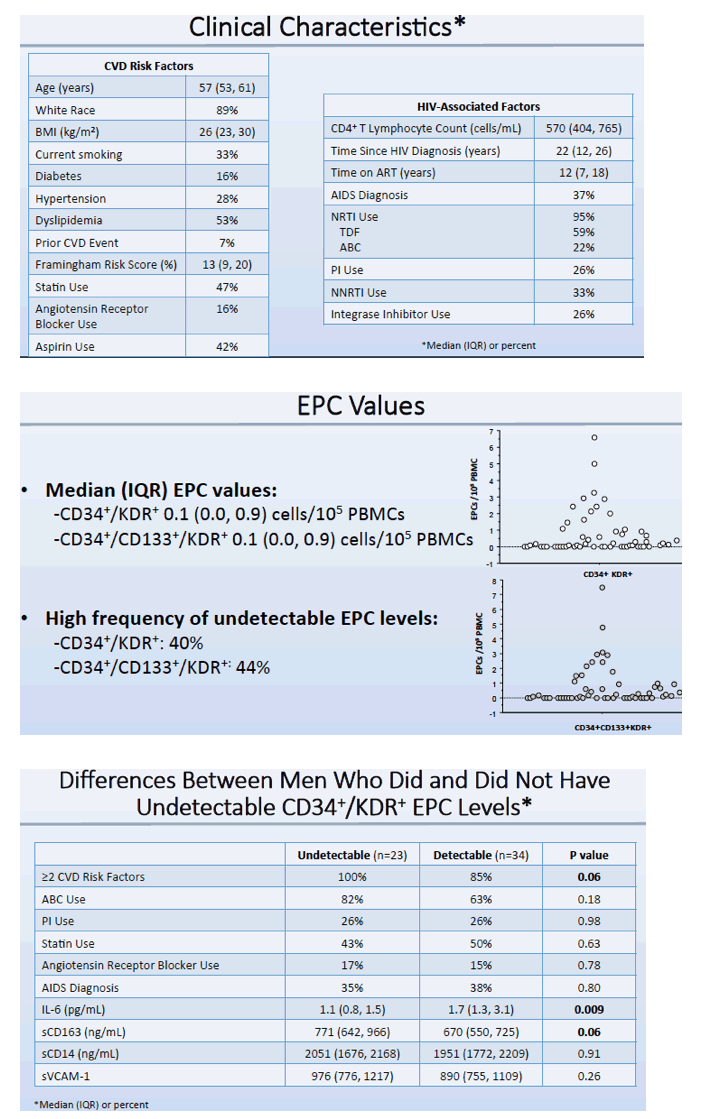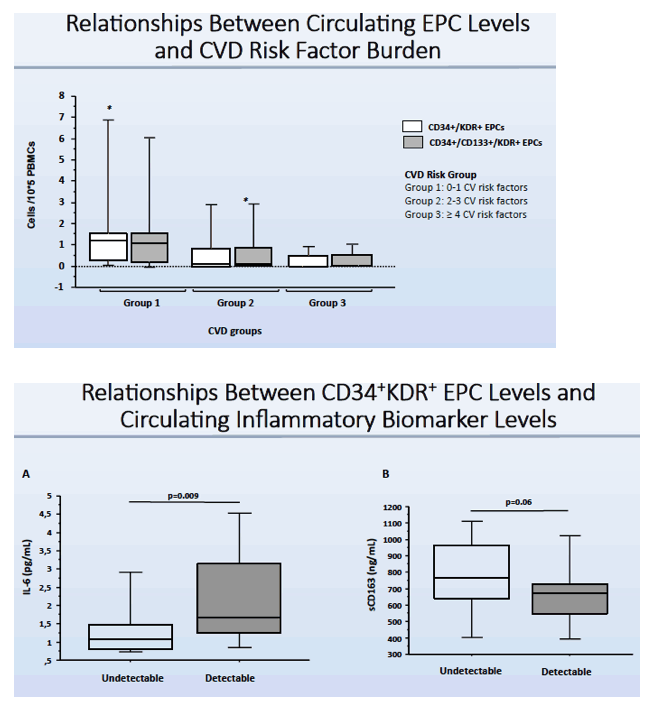 |
 |
 |
| |
Low Endothelial Progenitors Tied to CVD Risk, Activation in Older HIV+ Men - Endothelial Progenitor Cell Production is Suppressed and Associated with Systemic Inflammation and Monocyte Activation in Older HIV-Infected Men
|
| |
| |
IDWeek 2016, October 26-30, 2016, New Orleans
Mark Mascolini
Endothelial progenitor cell (EPC) levels were low and sometimes undetectable in a study of 57 older men with HIV infection [1]. Researchers at the University of Texas (UT) and University of California, Los Angeles (UCLA) linked undetectable EPC levels to higher cardiovascular risk and monocyte activation.
The UCLA team explained that EPCs originate in bone marrow, enter the circulation in response to stress or injury, repair damaged vascular endothelium, and promote new blood vessel formation [2]. Research links low levels of circulating EPCs to cardiovascular disease in the general population. Because relationships between EPCs, cardiovascular disease, and inflammation remain unclear in people with HIV, the UT/UCLA team conducted this study.
The analysis involved 57 HIV-positive men at least 50 years old and taking suppressive antiretroviral therapy (ART). The researchers isolated EPCs by flow cytometry homing on markers of cellular immaturity (CD34 and CD133) and endothelial commitment (KDR). They noted that cells with all three markers are rare in circulation but highly specific for endothelial lineage. They measured circulating biomarker levels in fasting participants and defined statistical significance as P < 0.10 for this pilot study.
Median age of study participants stood at 57 (interquartile range [IQR] 53 to 61), 89% were white, and 33% currently smoked. Proportions with dyslipidemia were 53%, hypertension 28%, and diabetes 16%. Almost half, 47%, used statins, 42% used aspirin, and 16% used angiotensin receptor blocks. Four of 57 men (7%) already had a cardiovascular event, and median Framingham cardiovascular risk score stood at 13% (IQR 9% to 20%). Median CD4 count measured 570 (IQR 404 to 765), a median of 22 years had passed since HIV diagnosis, and men had taken ART for a median of 12 years (IQR 7 to 18). About one quarter of participants had taken a protease inhibitor (26%) or abacavir (22%).
Median EPC values were low: 0.1 cells/100,000 peripheral blood mononuclear cells for both CD34/KDR cells and CD34/CD133/KDR cells. CD34/KDR EPCs could not be detected in 40% of men and CD34/CD133/KDR EPCs could not be detected in 44% of men.
Compared with the 34 men who had detectable CD34/KDR EPCs, the 23 with undetectable levels were more likely to have 2 or more cardiovascular risk factors (100% versus 85%, P = 0.06), had significantly lower IL-6 (1.1 versus 1.7 pg/mL, P = 0.009), and had significantly higher sCD163, a monocyte activation signal (771 versus 670 ng/mL, P = 0.06). The groups did not differ in use of protease inhibitors, abacavir, statins, or angiotensin receptor blockers. Circulating EPC levels were highest in men with 0 or 1 cardiovascular risk factor, lower in men with 2 or 3 risk factors, and lowest in men with 4 or more risk factors.
Levels of IL-6, an inflammation marker, are often elevated in people with HIV. The researchers suggested that significantly lower IL-6 and higher sCD163 in men with undetectable EPCs "reflect decreased stimulus for EPC production (lower IL-6) and monocyte activation (higher sCD163), both of which have been associated with cardiovascular disease development."
The UT/UCLA team concluded that undetectable EPCs are linked to greater cardiovascular disease risk, lower IL-6, and higher sCD163. These findings, they noted, "highlight the complexity of vascular reparative capacity in this population."
References
1. Seang S, Kelesidis T, Currier JS, Lake JE. Endothelial progenitor cell production is suppressed and associated with systemic inflammation and monocyte activation in older HIV-infected men. IDWeek 2016, October 26-30, 2016, New Orleans. Abstract 850.
2. Asahara T, Murohara T, Sullivan A, et al. Isolation of putative progenitor endothelial cells for angiogenesis. Science. 1997;275:964-967. http://science.sciencemag.org/content/275/5302/964.long




|
| |
|
 |
 |
|
|